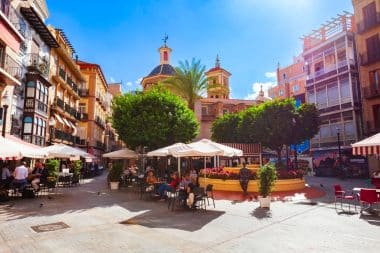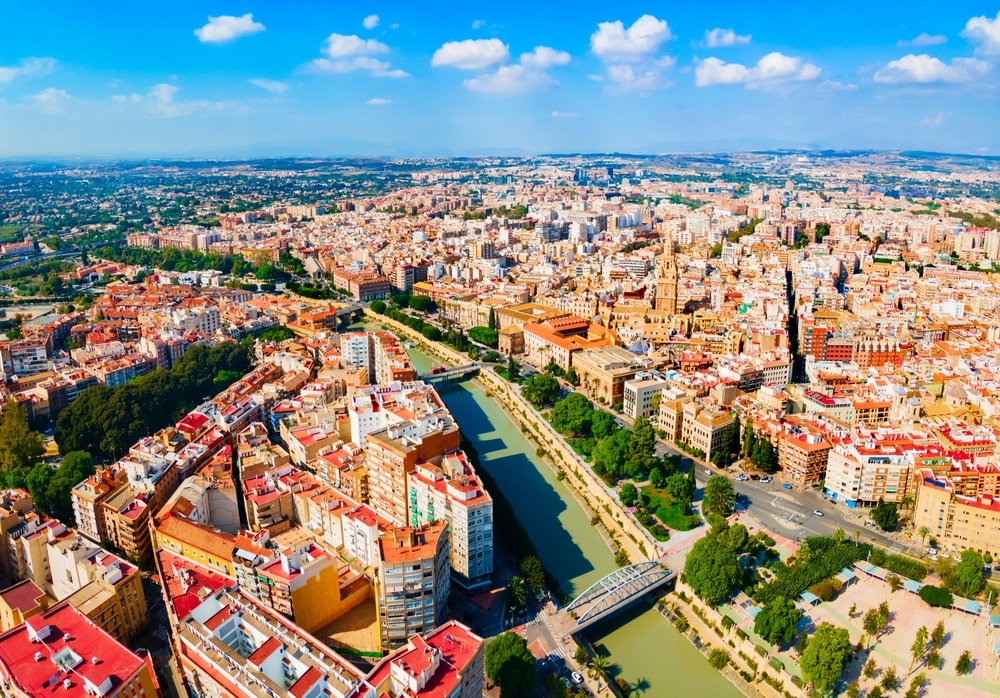The Spanish city of Murcia and the province of the same name have many attractions to offer both those interested in culture and nature lovers. Due to the wide range of tourist offers, a visit to Murcia is worthwhile at any time of the year. What tourists should know about the city and should definitely have seen can be found below.
Location and history
Murcia is located in the southeast of the popular holiday destination Spain. The distance between the city center and the Mediterranean coast is about 40 kilometers. The province of Murcia has several beautiful beaches. Examples include Playa de Bahia, Playa de Calblanque and Playa de Bolnuevo. The Segura River and the Andalusian Chain Mountains have a decisive influence on the landscape of the region. Northwest of the city rises the 2,015-meter-high mountain Revolcadores. The southeast of the province is characterized by the desert-like salt steppe with the Mar Menor saltwater lagoon. The latter is considered Europe’s largest saltwater lagoon with 170 square kilometers.
Murcia looks back on a long history: The city of Mursiya was founded as early as 825 by the then Emir of Córdoba. A sophisticated irrigation system led to the increasingly productive agriculture in the region. From 1266, Murcia belonged to the Kingdom of Castile. Natural disasters such as the flooding of the Segura River in 1651 and the earthquake in 1829 caused many deaths and destroyed buildings. Since 1982, Murcia has served as the capital of the Region of Murcia.
The sights in the old town

Despite the devastating damage caused by the earthquake mentioned above, Murcia has an old town worth seeing and experiencing. The Calles Trapería and Platería date back to the Middle Ages. Both street names stand for shopping pleasure in a successful combination of historic and modern buildings. Calle Trapería connects the Cathedral of Murcia in the south at the Plaza del Cardenal Belluga, with the Plaza de Santo Domingo in the north. Very close to the cathedral, with its beautiful Baroque façade and its precious relics from past centuries, is the Casino Real de Murcia. The highlights of the casino are the neo-baroque ballroom with impressive paintings and the Arabic courtyard, which is decorated with lots of gold leaf.
Must-see museums in Murcia
Museo Arqueológico
The Archaeological Museum of Murcia presents Iberian archaeology from the Region of Murcia. There is a permanent exhibition dedicated to the development from prehistoric times to the Bronze Age. These exhibits are supplemented by objects that date back to the time of the El Algar culture.
Address: Avda. Alfonso X El Sabio, 7 – 30008 Murcia, Phone: 968234602
Opening hours: From Tuesday to Friday from 10:00 a.m. to 2:00 p.m. and from 5:00 p.m. to 8:00 p.m.; Saturdays from 11:00 a.m. to 2:00 p.m. and from 5:00 p.m. to 8:00 p.m.; Sundays and holidays from 11:00 a.m. to 2:00 p.m.
July and August: From 10:00 a.m. to 2:00 p.m.
December 24 and 31 from 11:00 a.m. to 2:00 p.m.
Closed: Every Monday, December 25th, January 1st and 6th, Good Friday, Bando de la Huerta and Saturday of the Entierro de la Sardina.
Admission: Free
Museo de Santa Clara
Archaeological relics can also be seen in the Museum of the Monastery of Santa Clara. They are the remains of former royal palaces of Moorish and Christian origin. Nuns of the Order of the Poor Clares have been living in this monastery since 1365. The exhibition is divided into ecclesiastical art and secular objects from the Moorish period.
Address: Paseo Alfonso X El Sabio, s/n – 30007 Murcia Telephone: 968272398
Opening hours:
From Tuesday to Saturday from 10:00 a.m. to 1:00 p.m. and from 4:00 p.m. to 6:30 p.m. Sundays and public holidays from 10:00 a.m. to 1:00 p.m.
July and August: from Tuesday to Sunday from 10:00 to 13:00
Closed: Every Monday, December 25th, January 1st and 6th, Good Friday, Bando de la Huerta and Saturday of the Entierro de la Sardina.
Museo Salzillo
Francisco Salzillo, who was born in Murcia at the beginning of the 18th century, is the subject of the Salzillo Museum. The sculptor mainly created large sculptures for processions. A famous attraction is the Salzillo nativity scene, which is made up of more than 500 delicately crafted figures.
Summer opening hours (From 15 June to 15 September)
Monday: 10:00h – 14:00h
Tuesday: 10:00h – 14:00h
Wednesday: 10:00h – 14:00h
Thursday: 10:00h – 14:00h
Friday: 10:00h – 14:00h
Saturday: CLOSED
Sunday: CLOSED
Winter opening hours (From 16 September to 14 June)
Monday: 10:00h – 17:00h
Tuesday: 10:00h – 17:00h
Wednesday: 10:00h – 17:00h
Thursday: 10:00h – 17:00h
Friday: 10:00h – 17:00h
Saturday: 10:00h – 17:00h
Sunday: 11:00h – 14:00h**
Museo de Bellas Artes
The Museum of Fine Arts of the City of Murcia always offers interesting special exhibitions to art lovers. On a permanent basis, works by Spanish painters from the 16th to 18th centuries can be seen in this art museum. Among others, these are paintings by Jusepe de Ribera and Bartolomé Esteban Murillo. The museum is free of charge.
> Download museum brochure on the museum website
Opening hours:
From Tuesday to Friday from 10 a.m. to 2 p.m. and from 5 p.m. to 8 p.m.
Saturdays from 11 a.m. to 2 p.m. and from 5 p.m. to 8 p.m.
Sundays and public holidays from 11 a.m. to 2 p.m.
July and August
Tuesday to Friday from 10:00 a.m. to 2:00 p.m.,
Saturdays, Sundays and public holidays from 11:00 to 14:00.
December 24 and 31 from 11:00 a.m. to 2:00 p.m.
CLOSED
Every Monday, December 25, January 1 and 6, Good Friday, Bando de la Huerta and Saturday of the burial of the sardine.
The Castle of Monteagudo
A few kilometers northeast of the city center of Murcia, the Castillo de Monteagudo attracts with its partially preserved walls. In the Middle Ages, the castle, which is located on a hill, had an important importance as a fortress and prison. Not far from this castle there are relics of a Roman fort. The best view of the Murcia region is from the base of the Christ the Redeemer statue, which can be reached via a steep footpath. The division of the castle can still be seen, which is adapted to the nature of the terrain. Among other things, cisterns and granaries can still be seen in the south.
Tips for a trip to Murcia
As already stated, Murcia is always worth a visit. The Mediterranean climate in southeastern Spain promises mild winters, as the sea still provides sufficient warmth in the cold season. In summer, however, it can get very hot. The best travel times are therefore March – June and September – November.
What applies to the number and type of accommodation in Murcia also applies to gastronomy: there are so many restaurants, bars and cafés that every holidaymaker will find the right offer. The Plaza des las Flores is recommended to enjoy typical Spanish tapas and a glass of wine just like the locals do.
How to get there
The fastest way for travelers to reach Murcia is to opt for the plane. From the Aeropuerto Internacional de la Región de Murcia, it is only 20 kilometres to the city centre – for example by bus or taxi. If you prefer to travel by car, you will find a well-developed network of transport routes including motorways in the province of Murcia. The A-7 runs from Murcia to Valencia and Andalusia, the A-30 to Cartagena and Albacete.


